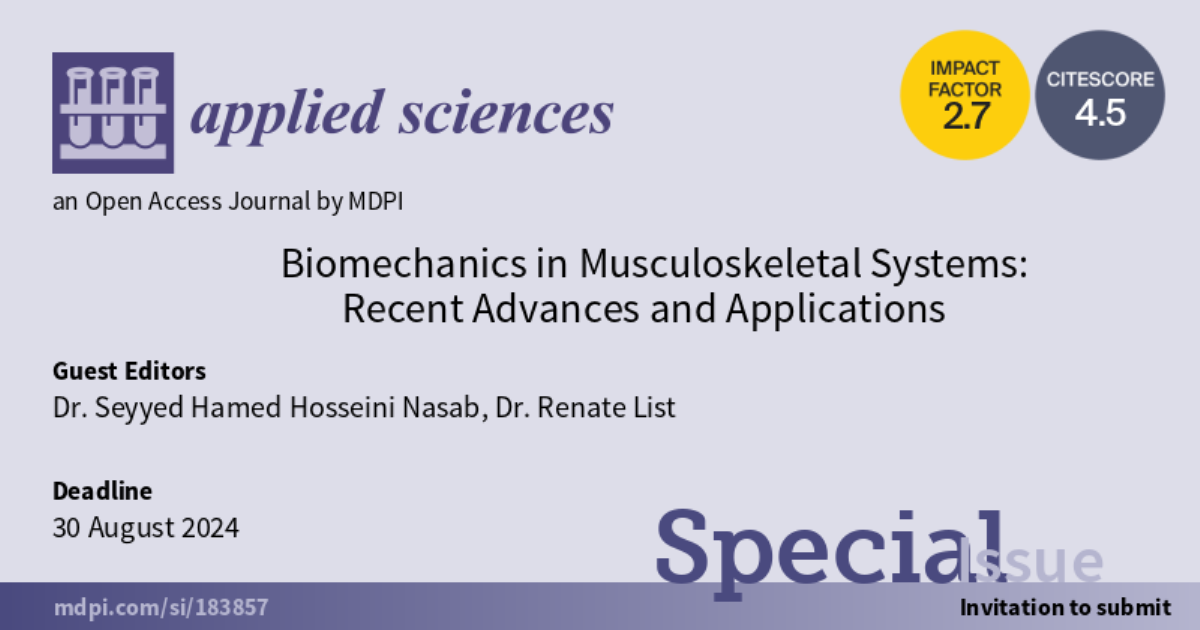Biomechanics in Musculoskeletal Systems: Recent Advances and Applications
A special issue of Applied Sciences (ISSN 2076-3417). This special issue belongs to the section "Applied Biosciences and Bioengineering".
Deadline for manuscript submissions: 28 February 2025 | Viewed by 2365

Special Issue Editors
Interests: kinematic and kinetic analysis of the healthy and replaced knee; musculoskeletal modelling
Special Issue Information
Dear Colleagues,
Understanding the biomechanics of the human musculoskeletal system is essential for advancing clinical practices, improving rehabilitation strategies, and enhancing the design of medical devices.
This Special Issue aims to collect articles covering a diverse range of topics, from experimental investigations to computational modeling and simulations addressing the biomechanical function of the healthy and pathologic musculoskeletal systems. Contributions in this Special Issue may also explore the integration of new technologies (e.g., wearable sensors and artificial intelligence) for capturing and analyzing functionality of the joints, muscles, tendons, and ligaments.
We eagerly await the submission of scientific manuscripts from experts in the field including engineers, biologists, and clinicians who pursued innovative approaches to address complex biomechanical problems, leading to groundbreaking advancements in the understanding and treatment of musculoskeletal disorders.
This Special Issue welcomes the submission of original research and review papers covering (but not limited to) the following topics:
- Musculoskeletal modelling;
- Human motion analysis;
- Personalized treatments;
- Kinematic and kinetic analysis of the human joints;
- Biomechanics of arthroplasty;
- Muscle, tendon, and ligament function;
- Muscle optimization;
- Computer methods in musculoskeletal biomechanics;
- Orthoses and prostheses.
Dr. Seyyed Hamed Hosseini Nasab
Dr. Renate List
Guest Editors
Manuscript Submission Information
Manuscripts should be submitted online at www.mdpi.com by registering and logging in to this website. Once you are registered, click here to go to the submission form. Manuscripts can be submitted until the deadline. All submissions that pass pre-check are peer-reviewed. Accepted papers will be published continuously in the journal (as soon as accepted) and will be listed together on the special issue website. Research articles, review articles as well as short communications are invited. For planned papers, a title and short abstract (about 100 words) can be sent to the Editorial Office for announcement on this website.
Submitted manuscripts should not have been published previously, nor be under consideration for publication elsewhere (except conference proceedings papers). All manuscripts are thoroughly refereed through a single-blind peer-review process. A guide for authors and other relevant information for submission of manuscripts is available on the Instructions for Authors page. Applied Sciences is an international peer-reviewed open access semimonthly journal published by MDPI.
Please visit the Instructions for Authors page before submitting a manuscript. The Article Processing Charge (APC) for publication in this open access journal is 2400 CHF (Swiss Francs). Submitted papers should be well formatted and use good English. Authors may use MDPI's English editing service prior to publication or during author revisions.
Keywords
- musculoskeletal modelling
- personalized treatments
- kinematic and kinetic analysis of the human joints
- muscle, tendon, and ligament function
- muscle optimization
- computer methods in musculoskeletal biomechanics
- orthoses and prostheses
Benefits of Publishing in a Special Issue
- Ease of navigation: Grouping papers by topic helps scholars navigate broad scope journals more efficiently.
- Greater discoverability: Special Issues support the reach and impact of scientific research. Articles in Special Issues are more discoverable and cited more frequently.
- Expansion of research network: Special Issues facilitate connections among authors, fostering scientific collaborations.
- External promotion: Articles in Special Issues are often promoted through the journal's social media, increasing their visibility.
- e-Book format: Special Issues with more than 10 articles can be published as dedicated e-books, ensuring wide and rapid dissemination.
Further information on MDPI's Special Issue polices can be found here.






